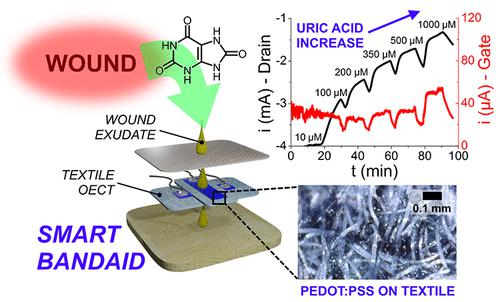Our official English website, www.x-mol.net, welcomes your
feedback! (Note: you will need to create a separate account there.)
Smart Bandaid Integrated with Fully Textile OECT for Uric Acid Real-Time Monitoring in Wound Exudate
ACS Sensors ( IF 8.2 ) Pub Date : 2023-03-17 , DOI: 10.1021/acssensors.2c02728 Danilo Arcangeli 1 , Isacco Gualandi 1 , Federica Mariani 1 , Marta Tessarolo 2 , Francesca Ceccardi 1 , Francesco Decataldo 2 , Federico Melandri 3 , Domenica Tonelli 1 , Beatrice Fraboni 2 , Erika Scavetta 1
ACS Sensors ( IF 8.2 ) Pub Date : 2023-03-17 , DOI: 10.1021/acssensors.2c02728 Danilo Arcangeli 1 , Isacco Gualandi 1 , Federica Mariani 1 , Marta Tessarolo 2 , Francesca Ceccardi 1 , Francesco Decataldo 2 , Federico Melandri 3 , Domenica Tonelli 1 , Beatrice Fraboni 2 , Erika Scavetta 1
Affiliation

|
Hard-to-heal wounds (i.e., severe and/or chronic) are typically associated with particular pathologies or afflictions such as diabetes, immunodeficiencies, compression traumas in bedridden people, skin grafts, or third-degree burns. In this situation, it is critical to constantly monitor the healing stages and the overall wound conditions to allow for better-targeted therapies and faster patient recovery. At the moment, this operation is performed by removing the bandages and visually inspecting the wound, putting the patient at risk of infection and disturbing the healing stages. Recently, new devices have been developed to address these issues by monitoring important biomarkers related to the wound health status, such as pH, moisture, etc. In this contribution, we present a novel textile chemical sensor exploiting an organic electrochemical transistor (OECT) configuration based on poly(3,4-ethylenedioxythiophene):polystyrene sulfonate (PEDOT:PSS) for uric acid (UA)-selective monitoring in wound exudate. The combination of special medical-grade textile materials provides a passive sampling system that enables the real-time and non-invasive analysis of wound fluid: UA was detected as a benchmark analyte to monitor the health status of wounds since it represents a relevant biomarker associated with infections or necrotization processes in human tissues. The sensors proved to reliably and reversibly detect UA concentration in synthetic wound exudate in the biologically relevant range of 220–750 μM, operating in flow conditions for better mimicking the real wound bed. This forerunner device paves the way for smart bandages integrated with real-time monitoring OECT-based sensors for wound-healing evaluation.
中文翻译:

与全纺织 OECT 集成的智能创可贴,用于实时监测伤口渗出液中的尿酸
难以愈合的伤口(即严重和/或慢性)通常与特定的病理或病痛有关,例如糖尿病、免疫缺陷、卧床不起的人的压迫性创伤、皮肤移植或三度烧伤。在这种情况下,至关重要的是要不断监测愈合阶段和整体伤口状况,以实现更有针对性的治疗和更快的患者康复。目前,这项手术是通过去除绷带并目视检查伤口来进行的,这使患者面临感染的风险并扰乱了愈合阶段。最近,通过监测与伤口健康状况相关的重要生物标志物(例如 pH 值、湿度等)开发了新设备来解决这些问题。在这篇文章中,我们提出了一种新型纺织化学传感器,利用基于聚(3,4-亚乙基二氧噻吩)的有机电化学晶体管 (OECT) 配置:聚苯乙烯磺酸盐 (PEDOT:PSS) 用于伤口渗出液中的尿酸 (UA) 选择性监测。特殊医疗级纺织材料的组合提供了一个被动采样系统,可以对伤口液体进行实时和非侵入性分析:UA 被检测为基准分析物以监测伤口的健康状况,因为它代表了相关的相关生物标志物在人体组织中出现感染或坏死过程。事实证明,这些传感器能够在 220-750 μM 的生物学相关范围内可靠且可逆地检测合成伤口渗出液中的 UA 浓度,在流动条件下运行以更好地模拟真实伤口床。
更新日期:2023-03-17
中文翻译:

与全纺织 OECT 集成的智能创可贴,用于实时监测伤口渗出液中的尿酸
难以愈合的伤口(即严重和/或慢性)通常与特定的病理或病痛有关,例如糖尿病、免疫缺陷、卧床不起的人的压迫性创伤、皮肤移植或三度烧伤。在这种情况下,至关重要的是要不断监测愈合阶段和整体伤口状况,以实现更有针对性的治疗和更快的患者康复。目前,这项手术是通过去除绷带并目视检查伤口来进行的,这使患者面临感染的风险并扰乱了愈合阶段。最近,通过监测与伤口健康状况相关的重要生物标志物(例如 pH 值、湿度等)开发了新设备来解决这些问题。在这篇文章中,我们提出了一种新型纺织化学传感器,利用基于聚(3,4-亚乙基二氧噻吩)的有机电化学晶体管 (OECT) 配置:聚苯乙烯磺酸盐 (PEDOT:PSS) 用于伤口渗出液中的尿酸 (UA) 选择性监测。特殊医疗级纺织材料的组合提供了一个被动采样系统,可以对伤口液体进行实时和非侵入性分析:UA 被检测为基准分析物以监测伤口的健康状况,因为它代表了相关的相关生物标志物在人体组织中出现感染或坏死过程。事实证明,这些传感器能够在 220-750 μM 的生物学相关范围内可靠且可逆地检测合成伤口渗出液中的 UA 浓度,在流动条件下运行以更好地模拟真实伤口床。











































 京公网安备 11010802027423号
京公网安备 11010802027423号